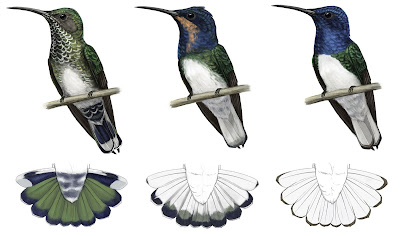Highlights
• Female white-necked jacobins are polymorphic—30% have male-like plumage
• All juveniles have male-like plumage, excluding sexual selection as an explanation
• Male-like females receive less con- and heterospecific social harassment
• Thus, male-like ornamentation in females can arise purely through non-sexual means
Summary
Ornamentation is typically observed in sexually mature adults, is often dimorphic in expression, and is most apparent during breeding, supporting a role for sexual selection in its evolution. Yet, increasing evidence suggests that nonsexual social selection may also have a role in the evolution of ornamentation, especially in females. Distinguishing between these alternatives remains challenging because sexual and nonsexual factors may both play important and overlapping roles in trait evolution. Here, we show that female ornamentation in a dichromatic hummingbird, the white-necked jacobin (Florisuga mellivora), cannot be explained by sexual selection. Although all males are ornamented, nearly 30% of females have male-like plumage. Remarkably, all juveniles of both sexes express ornamented plumage similar to adult males (androchromatism), but 80% of females acquire non-ornamented plumage (heterochromatism) as they age. This unique ontogeny excludes competition for mates as an explanation for female ornamentation because non-reproductive juveniles are more likely to be ornamented than adults. Instead, avoidance of social harassment appears to underlie this female-limited polymorphism, as heterochrome taxidermy mounts received more aggressive and sexual attention than androchrome mounts from this and other hummingbird species. Monitoring electronically tagged birds at data-logging feeders showed that androchrome females accessed feeders more than heterochrome females, presumably because of reduced harassment. Our findings demonstrate that ornamentation can arise purely through nonsexual social selection, and this hypothesis must be considered in the evolution of not only female-limited polymorphism but also the spectacular ornamentation often assumed to result from sexual selection.
Keywords: social selection, sexual selection, ornamentation, sexual dimorphism, plumage coloration, ontogeny, female-limited polymorphism, hummingbird, Trochilidae, Florisuga mellivora
 |
| The left and center images show adult female and adult male plumages, respectively. Right image shows juvenile plumage. |
Jay J. Falk, Michael S. Webster and Dustin R. Rubenstein. 2021. Male-like Ornamentation in Female Hummingbirds results from Social Harassment rather than Sexual Selection. Current Biology. DOI: 10.1016/j.cub.2021.07.043





